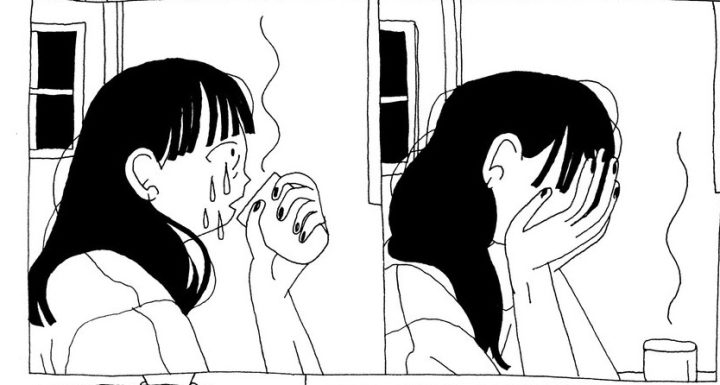Mirion Malle’s The League of Super Feminists was a nice surprise, a brightly colored, accessible, entertainingly drawn guide to basic intersectional feminist principles, the perfect thing to hand to your kid. Her This Is How I Disappear is quite a different thing: the story of a young writer and her friends as they experience varying degrees of mental stress and illness and cope with it or not. It’s almost the flipside of the previous book: black and white rather than color, for grown-ups (20- and 30-somethings mostly, I think, rather than those who have often moved on to phases of their life in which they have to care for others rather than just themselves), fiction rather than nonfiction (kind of; the book has the loose structure of a memoir rather than a more tightly plotted story), shown rather than told (there’s no narrator this time and a lot of dialogue as a consequence).
The images, too, are more seriously and intensely worked. The earlier book was mostly figures in empty spaces, hanging out on the page sans context. This one has foliage and offices, bedrooms and kitchens, parties and cars. These things are simple, mostly linework without a lot of areas of black and basically zero shading. What comes in for the most detail is technological devices, both computer and phone screens, which Malle renders with a clearly deep knowledge. She remembers the icons for battery life, starting a video call, adding emojis to a text, the indication of a lockscreen, and more, and she makes sure that they’re present because she feels that they’re important to show these pieces of circuitry accurately. The audience will know if they’re off and, what’s more, I guess they’ll care. In a book that is largely about the ocean of loneliness and the boats we try to row across it to find one another, technology is important. It’s one way we try to connect with each other, even as it often pulls us apart, both because we now know too much about one another. Malle’s book isn’t about tech, but tech is part of the universe in which it exists.
The counterpart to the hard, clean, imaginary virtual world is the soft, squishy human world, which provides the link to The League of Super Feminists. Malle’s lines are all woogly. The fingers she draws look like noodles. They’re long and thin, and they curl around in a way that’s vaguely uncomfortable to look at in an adult’s drawing. Emotions are the same way: wobbly and exaggerated. When people cry, they shed loads of tears, not just one or two. When they’re angry, their eyes squinch up, their eyebrows angle down toward their nose, their teeth clench, and a little puff of air comes shooting out of their nose, drawn almost like a classic cartoon fart. It’s a lot of feeling communicated in objectively very simple faces, with wee triangles for noses and mouths that can be nothing more than a brief horizontal line. Do they resemble emojis? You could make that case.
When I think about how people use emojis, it’s often with a spirit of comedic amplification. In a world in which our experiences often become muted through survival instinct (we process our fear of climate change-related disasters through memes), we can turn to extravagant overstatement of our feelings to communicate what they might be. Everyone understands that when you text someone a little yellow smiley laughing so hard that tears are coming out of its eyes, it’s not very likely that you’re actually amused to the point of crying. Hyperbole is the lingua franca of our era, with everything being best or worst, amazing or trash because we’re swamped by content and it’s the easiest way to get noticed. No one’s here for your take that such and such is a solid B-, even though the vast majority of creative efforts do fall into a middle range.
Malle also uses major close-ups on disembodied eyes or mouths or hands holding a phone to suggest fragmentation and stress, making literal the difficulty of holding oneself together. Sometimes her characters’ features disappear, or their own speech bubble might completely cover their face. Sometimes a speech bubble squeezes up against the bottom of a panel and gets a little cut off. The League of Super Feminists was an effort in deliberate messiness, and I think the same is true here but with a different intention. That book was doing it out of a desire to welcome all. This one does it to communicate pain and depression, the oppressiveness of existing in the world. The book as a whole makes me feel really sorry for younger millennials, whose expectations were high and who therefore feel the pain of a shitty, dead-end, pink-collar job more than they otherwise might. But it’s also hard to tell if Malle intends to say anything about a generation or if she’s more preoccupied with conveying the way it feels to experience depression and the lingering effects of abuse. The latter might end up being the former.









